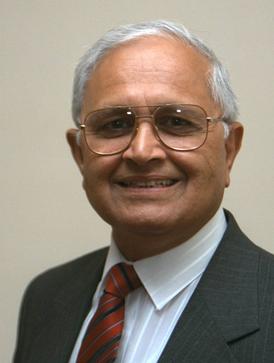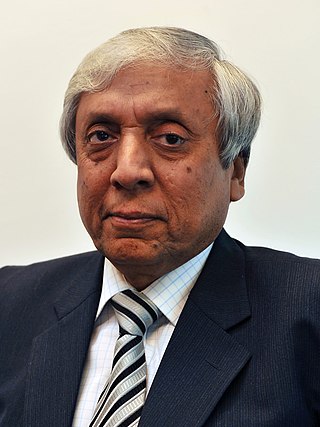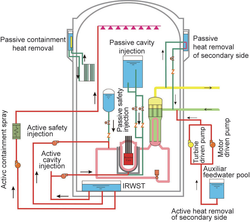
The CANDU is a Canadian pressurized heavy-water reactor design used to generate electric power. The acronym refers to its deuterium oxide moderator and its use of uranium fuel. CANDU reactors were first developed in the late 1950s and 1960s by a partnership between Atomic Energy of Canada Limited (AECL), the Hydro-Electric Power Commission of Ontario, Canadian General Electric, and other companies.

A nuclear reactor is a device used to initiate and control a fission nuclear chain reaction or nuclear fusion reactions. Nuclear reactors are used at nuclear power plants for electricity generation and in nuclear marine propulsion. Heat from nuclear fission is passed to a working fluid, which in turn runs through steam turbines. These either drive a ship's propellers or turn electrical generators' shafts. Nuclear generated steam in principle can be used for industrial process heat or for district heating. Some reactors are used to produce isotopes for medical and industrial use, or for production of weapons-grade plutonium. As of 2022, the International Atomic Energy Agency reports there are 422 nuclear power reactors and 223 nuclear research reactors in operation around the world.

A pressurized water reactor (PWR) is a type of light-water nuclear reactor. PWRs constitute the large majority of the world's nuclear power plants. In a PWR, the primary coolant (water) is pumped under high pressure to the reactor core where it is heated by the energy released by the fission of atoms. The heated, high pressure water then flows to a steam generator, where it transfers its thermal energy to lower pressure water of a secondary system where steam is generated. The steam then drives turbines, which spin an electric generator. In contrast to a boiling water reactor (BWR), pressure in the primary coolant loop prevents the water from boiling within the reactor. All light-water reactors use ordinary water as both coolant and neutron moderator. Most use anywhere from two to four vertically mounted steam generators; VVER reactors use horizontal steam generators.
Nuclear power in Canada is provided by 19 commercial reactors with a net capacity of 13.5 gigawatt (GW), producing a total of 95.6 terawatt-hours (TWh) of electricity, which accounted for 16.6% of the country's total electric energy generation in 2015. All but one of these reactors are located in Ontario, where they produced 61% of the province's electricity in 2019. Seven smaller reactors are used for research and to produce radiopharmaceuticals for use in nuclear medicine.
The Chashma Nuclear Power Plant is a large commercial nuclear power plant located at Chashma in Mianwali, Punjab, Pakistan.
In Pakistan, the nuclear power is provided by six commercial nuclear power plants with a net capacity of 3,262 megawatts (3.262 GW) with the pressurized water reactors. In 2020, the nuclear power plants have produced a total of 133 terawatt-hours of electricity, which accounted for roughly 10% of the nation's total electric energy generation.

China is one of the world's largest producers of nuclear power. The country ranks third in the world both in total nuclear power capacity installed and electricity generated, accounting for around one tenth of global nuclear power generated. As of February 2023, China has 55 plants with 57GW in operation, 22 under construction with 24 GW and more than 70 planned with 88GW. About 5% of electricity in the country is due to nuclear energy. These plants generated 417 TWh of electricity in 2022 This is versus the September 2022 numbers of 53 nuclear reactors, with a total capacity of 55.6 gigawatt (GW). In 2019, nuclear power had contributed 4.9% of the total Chinese electricity production, with 348.1 TWh.

Kakrapar Atomic Power Station is a nuclear power station in India, which lies in the proximity of Mandvi, Surat and Tapi river in the state of Gujarat.
Nuclear power is the fifth-largest source of electricity in India after coal, gas, hydroelectricity and wind power. As of November 2020, India has 22 nuclear reactors in operation in 8 nuclear power plants, with a total installed capacity of 7,380 MW. Nuclear power produced a total of 43 TWh in 2020–21, contributing 3.11% of total power generation in India. 10 more reactors are under construction with a combined generation capacity of 8,000 MW.
The Pakistan Nuclear Power Fuel Complex (PNPFC), also known as Chemical Processing Plant (CPP), is a nuclear fuel manufacturing and a fabrication plant located in about 175 km (109 mi) south of Islamabad, possibly in Faisalabad District in Punjab.
Nuclear power in Romania provides around 20% of its electricity, with two nuclear reactors commencing operations in 1996 and 2007. In 2020, Romania generated a total of 56.1 TWh of electricity. The generation mix was composed of hydro (28%), nuclear (20%), natural gas (15%), coal (17%), wind (12%), solar (3%), and biofuels & waste. The Romanian government strongly supports nuclear energy.

Munir Ahmad Khan, NI, HI, FPAS, was a Pakistani nuclear reactor physicist who is credited, among others, with being the "father of the atomic bomb program" of Pakistan for their leading role in developing their nation's nuclear weapons during the successive years after the war with India in 1971.

Parvez Butt, is a Pakistani mechanical engineer and public official who served as the chairman of the Pakistan Atomic Energy Commission from 2001 till 2006.

Ansar Pervaiz, also spelled as, HI, is a Pakistani scientist and a nuclear engineer who was the former chairman of the Pakistan Atomic Energy Commission (PAEC), and former chairman of the Board of Governors of International Atomic Energy Agency (IAEA). Pervaiz is widely given credit for establishing the nuclear engineering, nuclear physics and nuclear technology institutes within Pakistan.

The Wolseong Nuclear Power Plant, or Wolsong, is a nuclear power plant located on the coast near Nae-ri, Yangnam-myeon, Gyeongju, North Gyeongsang province, South Korea. It is the only South Korean nuclear power plant operating CANDU-type PHWR. Korea Hydro & Nuclear Power owns the plant. These reactors are capable of consuming multiple types of fuel, including wastes from South Korea's other nuclear plants.
Fangchenggang Nuclear Power Plant, also known as Fangchenggang Hongsha Nuclear Power Plant, is a nuclear power plant in Fangchenggang, near Hongshacun Village, autonomous region of Guangxi in the People's Republic of China. A total of six reactors are planned to operate at the Fangchenggang site. Units 1 and 2 are both CPR-1000s, units 3–4 are Hualong Ones, units 5–6 are planned also to be Hualong One reactors. Fangchenggang 3 and 4 will be the reference plant for the proposed Bradwell B plant in the UK.

Thorium-based nuclear power generation is fueled primarily by the nuclear fission of the isotope uranium-233 produced from the fertile element thorium. A thorium fuel cycle can offer several potential advantages over a uranium fuel cycle—including the much greater abundance of thorium found on Earth, superior physical and nuclear fuel properties, and reduced nuclear waste production. One advantage of thorium fuel is its low weaponization potential. It is difficult to weaponize the uranium-233 that is bred in the reactor. Plutonium-239 is produced at much lower levels and can be consumed in thorium reactors.

The Hualong One is a Chinese Generation III pressurized water nuclear reactor jointly developed by the China General Nuclear Power Group (CGN) and the China National Nuclear Corporation (CNNC). The CGN version, and its derived export version, is called HPR1000. It is commonly mistakenly referred to in media as the "ACPR1000" and "ACP1000", which are in fact earlier reactors design programs by CGN and CNNC.

The IPHWR-700 is an Indian pressurized heavy-water reactor designed by the NPCIL. It is a Generation III reactor developed from earlier CANDU based 220 MW and 540 MW designs. It can generate 700 MW of electricity. Currently there is two unit operational, 6 units under construction and 8 more units planned, at a cost of ₹1.05 lakh crore (US$13 billion).
















